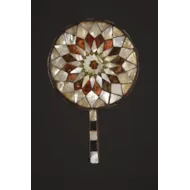An Ottoman Turkish Intarsia Hand Mirror Decorated with a Geometric Design Radiating from a Central Star
An Ottoman Turkish Intarsia Hand Mirror Decorated with a Geometric Design Radiating from a Central Star
The walnut inlaid with tortoiseshell mother-of-pearl and green stained ivory, the rim veneered with ebony and mother-of-pearl, original silvered glass mirror plate intact
17th / 18th Century
Size: 34cm high, 21.5cm dia. 1.5cm deep – 13¼ ins high, 8½ ins dia. ½ ins deep
The walnut inlaid with tortoiseshell mother-of-pearl and green stained ivory, the rim veneered with ebony and mother-of-pearl, original silvered glass mirror plate intact
17th / 18th Century
Size: 34cm high, 21.5cm dia. 1.5cm deep – 13¼ ins high, 8½ ins dia. ½ ins deep
There was a belief in the Muslim near east that mirrors had talismanic association. They were a potentially utilitarian object that bridged the ordinary with the extraordinary. This had probably developed in response to legends associated with religious and powerful figures. For example: Adam, Solomon and Alexander the Great, known as Iskandar reputedly possessed talismanic mirrors with magical powers that could show the future and provided their owners with secret knowledge. As instruments of reflection mirrors became conceptualised in a mystical framework eliciting a vision of the world and of the self.
An Ottoman Turkish Intarsia Hand Mirror Decorated with a Geometric Design Radiating from a Central Star

SOLD


YOU MAY ALSO LIKE

